LG GM-F238SS Owner’s Manual

<![endif]>ENGLISH
OWNER’S MANUAL
BOTTOM FREEZER REFRIGERATOR
Please read this manual carefully before operating your set and retain it for future reference.
Model Name
GM-F238SS
P/No. MFL61987630 |
www.lg.com |

TABLE OF CONTENTS
Important Safety Instructions |
2-3 |
Requirements for Ground Connection |
3 |
Parts and Features |
4 |
Refrigerator Installation |
5-11 |
Unpacking |
5 |
Installation |
5 |
Installation of Base Grille |
5 |
How to remove and install Handle |
6 |
How to remove and Install the |
|
Refrigerator Doors |
7-8 |
How to remove and Install Pull-Out Drawer |
9-10 |
Closing and Aligning the doors |
11 |
Using your Refrigerator |
12-17 |
Ensuring Proper Air Circulation |
12 |
Multi Flow |
12 |
Door Alarm |
12 |
Setting the controls |
12 |
Adjusting Control Settings |
13 |
Water Dispenser |
13 |
Food Storage Guide |
14 |
Storing Frozen Food |
14 |
Refrigerator Section |
15-17 |
Refrigerator Shelves |
15 |
Frozen Meat Compartment |
15 |
OptiBin Crispers |
16 |
Crisper cover with interior lattice |
16 |
Door Racks |
16 |
Dairy Compartment |
17 |
Egg Compartment |
17 |
Freezer Section |
17 |
Ice Bin |
17 |
DuraBase |
17 |
Durabase Divider |
17 |
Tilting Door |
17 |
Glide Out Drawer |
17 |
Refrigerator Care and Cleaning |
18-20 |
Refrigerator Cleaning |
18 |
Outside |
18 |
Inside |
18 |
Door Lining & Gaskets |
18 |
Plastic Parts (Covers and Panel) |
18 |
Back Cover |
18 |
Replacing Refrigerator Lights |
18 |
Replacing Freezer Lights |
19 |
Power Interruptions |
19 |
When Going on Vacation |
19 |
When Moving |
19 |
Water Filter |
20 |
About the Automatic Icemaker |
21 |
Connecting the Water Line |
22-24 |
Troubleshooting Guide |
24-27 |
1
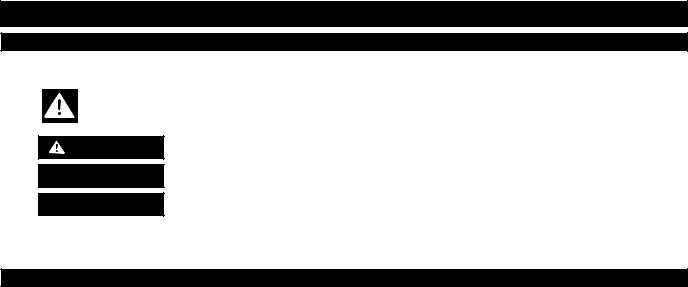
IMPORTANT SAFETY INSTRUCTIONS
SAFETY MESSAGES
This manual contains several important safety notices. Always read and obey all of the following safety messages.
This is the safety alert symbol. This symbol is a warning to potential dangers that could cause death, injury or damage to you, others or the product. All safety messages will follow after this warning symbol and the word “DANGER”, “CAUTION” or “WARNING”. These words mean:
DANGER

 WARNING
WARNING

 CAUTION
CAUTION
You may be killed or suffer fatal damage if you do not follow instructions.
You may be killed or seriously injured if you do not follow instructions.
Indicates a potentially hazardous situation which, if not avoided, may result in minor injury or damage to the product.
All safety messages inform you of potential danger, advise you on how to reduce the risk of injury and tell you what can occur if the instructions are not followed.
 WARNING
WARNING
To reduce the risk of fire, electrical shock or personal injury, the following precaution measures should be followed:
•NEVER disconnect the refrigerator by pulling the power cord, always grip the plug firmly and disconnect it directly from the outlet.
•Immediately repair or replace all faulty or damaged service cables. Do not use cords that have cracks or abrasion damage on the length of the cord or on the plug.
•When moving your refrigerator, take care not to roll over the electrical cord.
•DO NOT store or use gasoline or other combustible liquids or vapors in proximity with this or any other electrical appliance.
•DO NOT permit children to climb, stand or swing from the doors or shelves of the refrigerator. This can cause serious injury to them and damage to the product.
•Keep your fingers away from areas in which they can become caught, such as the doors, hinges and cabinets. Be careful closing the doors when children are near.
•Unplug the refrigerator before cleaning or repairing. NOTE: We strongly recommend that any repair services be performed by a qualified professional.
•Before replacing a burned-out light bulb, unplug the refrigerator or shut down the circuit breaker to avoid contact with a live wire (the bulb could break while being replaced). NOTE: Setting the control to the OFF position does not disconnect the power from the light bulb circuit.
•Do not keep bottles in the freezer compartment, they could explode after freezing and cause damage.
•For your safety, this product should be properly grounded. Have a qualified professional check the electrical circuit and outlet to ensure a proper ground connection.
•Read all instructions before utilizing the product. Utilize this product only as explicitly expressed in this guide.
•Once the refrigerator is operating, avoid touching cold surfaces of the freezer with damp or wet hands; the skin could become adhered to these surfaces.
•In refrigerators with an automatic ice dispenser, avoid contact with moving parts of the ejector mechanism or with the heating mechanism that discharges the cubes. DO NOT place your fingers or hands in the ice dispenser mechanism while the refrigerator is connected.
•DO NOT refreeze foods which have already thawed.
“...You can refreeze food that has thawed if they contain ice crystals or are cold and below 40 °F (4 °C)”.
“...Ground beef, perishable food or seafood that is discolored or has an unpleasant odor should not be frozen or consumed. Consumption of melted ice cream should also be avoided. If the odor or color of food is questionable, discard it. The food may be dangerous to consume”.
“Partial thawing or refreezing reduces the quality of the food, especially fruit, vegetables and prepared meals. The quality of red meat is less affected than other foods. Use refrozen products as soon as possible in order to maintain their quality”.
KEEP THESE INSTRUCTIONS
2
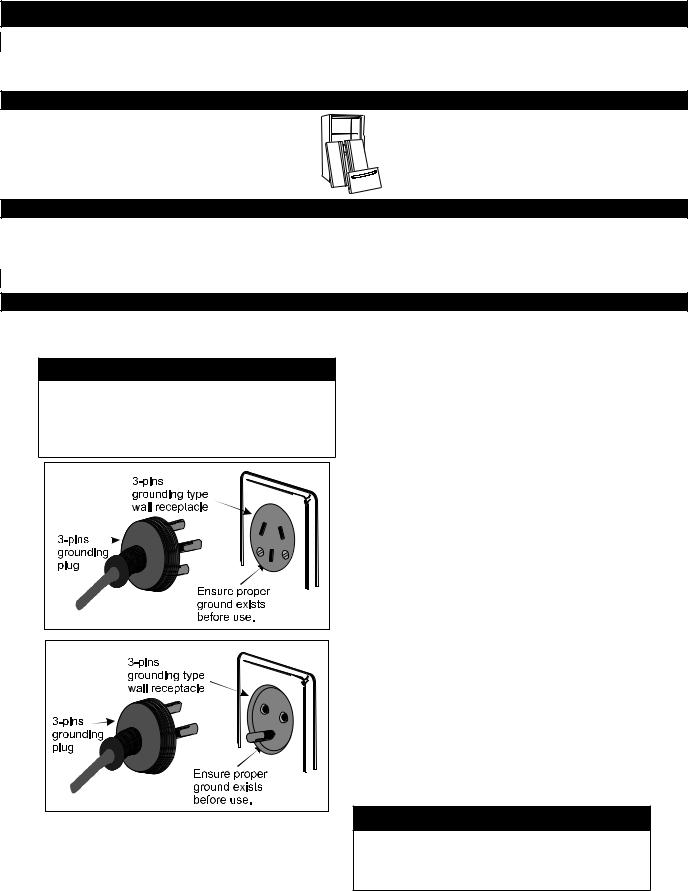
 CAUTION
CAUTION
This appliance is not intended for use by children, persons with physical or mental disabilities, persons with reduced sensory or mental capacity, or persons with lack of experience or know-how, unless they have supervision or instruction in relation to the use of the appliance by the person responsible for their safety. Children should be supervised to assure that they do not play with the appliance.
 DANGER: CHILDREN MAY BECOME TRAPPED
DANGER: CHILDREN MAY BECOME TRAPPED
Children becoming trapped or suffocated is not a problem of the past. Discarded and abandoned refrigerators are a hazard, even if they remain there “for just a few days”. If you would like to dispose of your old refrigerator, please follow the instructions below to prevent any accidents.
BEFORE DISPOSING YOUR REFRIGERATOR OR FREEZER WHEN NO LONGER IN USE:
•Remove the doors.
•Leave the shelves in place so that children cannot easily become stuck in them.
CFC DISPOSAL
Your old refrigerator may have a cooling system that uses CFC’s (chlorofluorocarbons). CFC affects the stratospheric layer of the ozone.
If you decide to throw out your old refrigerator, ensure that CFC contaminants are properly disposed of by a qualified professional. If you intentionally remove the CFC refrigerant, you could be subject to fines or prison in accordance with environmental legislation in effect.
REQUIREMENTS FOR GROUND CONNECTION
IMPORTANT: Please read carefully.
TO CONNECT ELECTRICITY
 WARNING
WARNING
ELECTRICAL SHOCK HAZARD
FOR YOUR PERSONAL SAFETY, this appliance must be properly grounded (earthed). Have a qualified electrician check your wall outlet to ensure that the plug is grounded properly.
RECOMMENDED GROUNDING METHOD (Plug type depending on region)
Your refrigerator must always be plugged to its own outlet which is adequately grounded. The energy current should only be 240 Volts, 50 Hz, A.C. and fused at 10 Amperes.
This provides the best performance and prevents an overload which could cause a fire from the overheating of the cables. It is recommended that a separate circuit be used for this appliance, as well as a receptacle that cannot be disconnected with a switch.
Do not use an extension cable.
ACCESSIBILITY OF SUPPLY CORD
When you decide the placement of your refrigerator, as a stationary appliance, it should have its plug accessible at all times.
Where a standard two-prong wall outlet is encountered, it is your personal responsability and obligation to have it replaced with a properly grounded three-ping wall outlet.
Do not, under any circumstance, cut or extract the third (pin) prong from the power cord.
NOTE: Before installation, cleaning or replacing light bulbs, you must disconnect the appliance from the power source. When finished, plug the appliance back in and adjust the thermostat to the desired position.
DO NOT USE EXTENSION CORDS
Because of potential safety hazards under certain condition, we strongly recommend against the use of an extension cord.
 WARNING
WARNING
REPLACING ELECTRICAL CABLE
If the power cord is damaged, it must be replaced by our service center or qualified LG technician to avoid any risk.
3
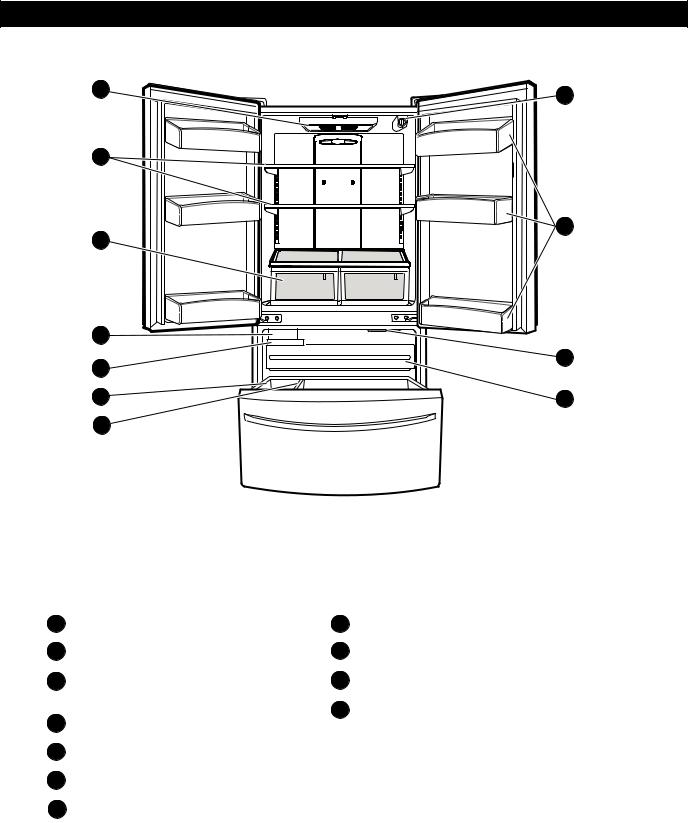
PARTS AND FEATURES
Drawer Model
A |
L |
|
|
B |
|
C |
K |
|
|
D |
|
E |
J |
|
|
F |
I |
G |
|
Read this section to familiarize yourself with the parts and features of your new refrigerator.
NOTE: This guide covers different models. Your refrigerator could have some or all of the features and parts listed below. The location of some of the parts may not correspond to that of your model.
A |
Refrigerator Light |
I |
Pull Out Drawer |
B |
Shelves |
J |
Freezer Light |
C |
Optibin Crisper |
K |
Door Racks |
|
Keeps fruits and vegetable fresh and crisp |
L |
Water Filter |
|
|
DIcemaker*
EIce Bin*
FDurabase
GDurabase divider
* On some models
4
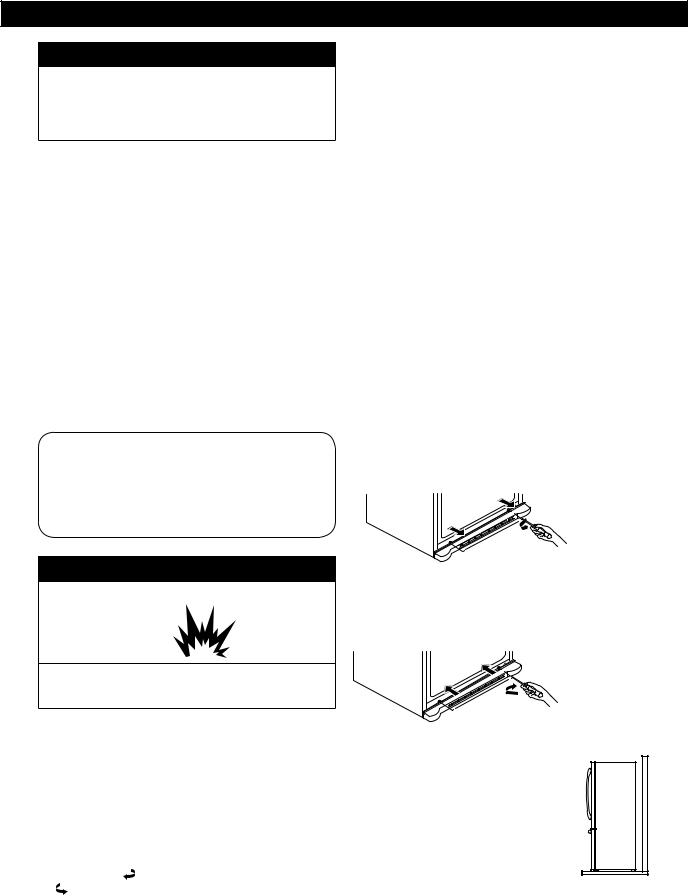
REFRIGERATOR INSTALLATION
 WARNING
WARNING
EXCESSIVE WEIGHT HAZARD
Use the assistance of two or more persons to move or install the refrigerator. Not following these instructions may cause injury to the back and other parts of the body.
UNPACKING
Before installing your refrigerator, remove any tape or temporary stickers. Do not remove any stickers that feature warnings, the model serial number or the technical label of the product located on the back of the refrigerator.
To remove adhesive tape residue, rub it well with your fingers and a little liquid detergent. Clean with warm water and let dry.
Do not use sharp instruments, rubbing alcohol, flammable liquids or abrasive cleaning products to remove the adhesive tape or glue. These products can damage the surface of your refrigerator. For more information, see the section on “Important Safety Instructions”.
The shelves come already installed in their factory position. Remove the shelves and replace them according to your spacing needs.
Moving Your Refrigerator:
Your refrigerator is extremely heavy. Make sure you protect the floor when moving your refrigerator for cleaning or servicing. Always pull your refrigerator straight out when moving it. Do not shift from side to side or “walk” the refrigerator when attempting to move it as this can cause damage to the floor.
 WARNING
WARNING
EXPLOSION HAZARD
Keep all flammable materials and vapors (such as gasoline) away from the refrigerator. Not following these instructions may cause death, explosion or fire
INSTALLATION
 CAUTION: Avoid placing the unit near heat sources, direct sunlight or humidity.
CAUTION: Avoid placing the unit near heat sources, direct sunlight or humidity.
1.To avoid vibration, the unit should be leveled. If needed, adjust the leveling screws to compensate for an unleveled floor. The front should be slightly taller than the rear to ensure that the doors close properly. The leveling screws can easily be turned by slightly tilting the front of the refrigerator, turning the leveling screws
clockwise ( |
|
|
|
) to raise it and counter-clockwise |
||||
|
|
|
||||||
|
|
|
||||||
( |
|
|
|
) to lower it. |
||||
|
|
|
||||||
2.Install the refrigerator in an area between 55 °F
(13 °C) and 110 °F (43 °C). If the surrounding temperature is lower or higher than previously mentioned, it can adversely affect the unit.
ONCE INSTALLED
1.Carefully clean your refrigerator and remove and dust accumulated during shipping.
2.Install accessories such as the ice bin, door racks, shelves, etc., in their proper places. These are already packed to prevent any possible damage during shipping.
3.Leave your refrigerator on for 2 to 3 hours before storing food inside. Verify that there is a flow of cold air in the freezer compartment to ensure proper cooling. Your refrigerator is now ready for use.
 WARNING:
WARNING:
•Take care when working with the hinges, base cover and stops, etc. You may injure yourself.
•DO not place your hands or any tools in the air vents, the base cover or in the bottom of the refrigerator. This may cause injury or electrical shock.
INSTALLATION OF BASE GRILLE
Uninstalling or Replacing the Base Grille
1.Remove the 2 screws from the bottom front part of your refrigerator (see Figure A).
2.Take off the cover.
Figure A
Installing the Base Grille
1.Align the bottom cover and place in position. Insert the 2 screws and twist in place (see Figure B).
Figure B
Keep a Proper Distance from Adjacent Objects
Please keep the refrigerator at an adequate distance from other objects. Insufficient spacing can reduce the refrigerator’s freezing efficiency and increase electricity consumption.
(5.08 cm) 2” 


5

REFRIGERATOR INSTALLATION
TOOLS YOU MAY NEED
10 mm (.375 in) |
|
6.35 mm (1/4 in) |
6.35 mm (1/4 in) |
9.52 mm (3/8 in) |
2.38 mm (3/32 in) |
Hex Socket Wrench Phillips Screwdriver Flat Head Screwdriver |
Allen Wrench |
NOTE: It is always recommended that the doors be removed when it is necessary to move the refrigerator through a narrow opening. If it is necessary to remove the handles follow the directions below.
NOTE: Handle appearance may vary from illustrations on this page.
DOOR HANDLE REMOVING
1. Removing Refrigerator Handle
Loosen the set screws with the 2.38 mm (3/32 in) Allen wrench and remove the handle.
•NOTE: If the handle mounting fasteners need to be
tightened or removed, use a 6.35 mm (1/4 in) Allen wrench.
Mounting
Fasteners
Set Screw
Allen Wrench
2. Removing Freezer Drawer Handle
Loosen the set screws located on the lower side of the handle with the 3.17 mm (1/8 in) Allen wrench and remove the handle.
NOTE: If the handle mounting fasteners need to be tightened or removed, use a 6.35 mm (1/4 in) Allen wrench.
DOOR HANDLE INSTALLATION
1. Reinstalling Refrigerator Handle
Place the handle on the door by aligning handle footprints to fit mounting fasteners and
tighten the set screws with a 2.38 mm (3/32 in) Allen wrench.
NOTE: If the handle mounting fasteners need to be tightened or removed, use a 6.35 mm (1/4 in) Allen wrench.
Mounting
Fasteners
2. Reinstalling Freezer Drawer Handle
Place the handle on the door by aligning handle footprints to fit mounting fasteners and tighten the set screws on the bottom of the handle with a 3.17 mm (1/8 in) Allen wrench.
NOTE: If the handle mounting fasteners need to be tightened or removed, use a 6.35 mm (1/4 in) Allen wrench.
6
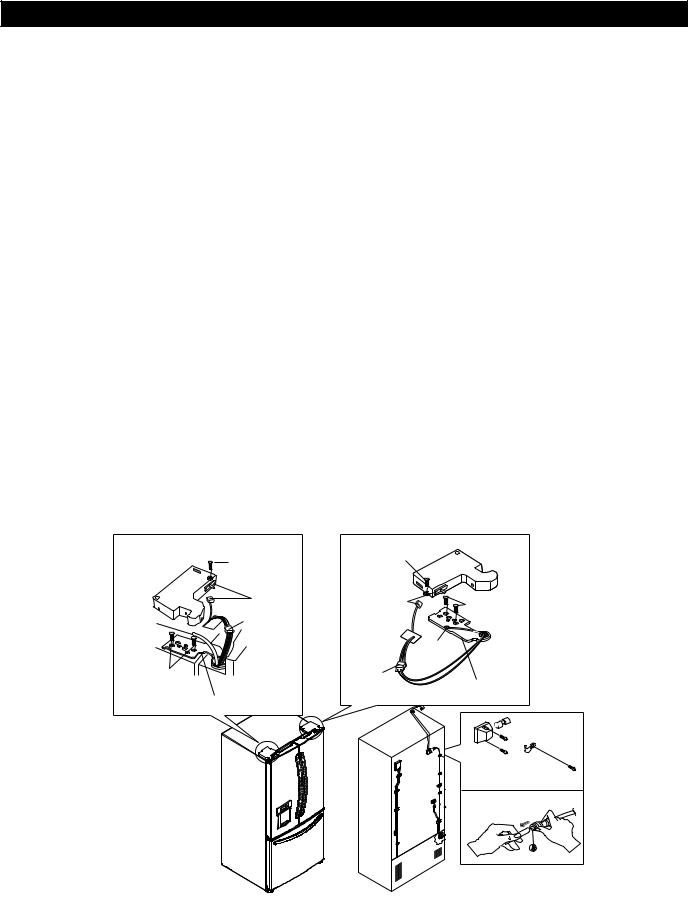
REFRIGERATOR INSTALLATION
HOW TO REMOVE AND INSTALL REFRIGERATOR DOOR
1. Removing Refrigerator Doors
Remove the left-side door first.
NOTE: Handle, top hinge and hinge cover appearance may vary from illustrations on this page.
 WARNING
WARNING
•Disconnect electrical supply to the refrigerator before installing. Failure to do so could result in death or serious injury.
•Do not put hands or feet or metal sticks into the air vents, base grille, or bottom of the refrigerator. You may be injured or receive an electrical shock.
•Be careful when you work with the hinge, base grille, and stopper. You may be injured.
•Remove food and any bins from doors.
XX Left Door
•Loosen the screws and remove the cover on back side (see figure A).
•Disconnect water supply tube by pushing back on the disconnect ring (3).
•Loosen the cover screw (1).
•Disconnect door switch wire (2).
•Pull out the tube (4).
 CAUTION: If a tube end is deformed or worn out, cut the damaged portion away.
CAUTION: If a tube end is deformed or worn out, cut the damaged portion away.
•Disconnect wire harness (5).
•Loosen screws (6) and lift off the top hinge (7).
•Place the door on a non-scratching surface with the inside up.
 CAUTION: When removing top hinge, be careful that the door does not fall forward.
CAUTION: When removing top hinge, be careful that the door does not fall forward.
XX Right Door
•Loosen the cover screw (1).
•Disconnect door switch wire (2).
•Disconnect wire harness (4).
•Remove the ground screw (8).
•Loosen screws (6) and lift off the top hinge (7).
•Place the door on a non-scratching surface with the inside up.
(1) |
(1) |
|
|
(2) |
(2) |
(6) |
|
|
|
|
(4) |
(5) |
|
|
|
|
|
(8) |
(6) |
(4) |
|
(7) |
Figure A
3
7

REFRIGERATOR INSTALLATION
HOW TO REMOVE AND INSTALL REFRIGERATOR DOOR (CONT.)
2. Refrigerator Door Reinstallation
Install the right-side door first.
XX Right Door
•Lower the door onto the middle hinge pin (1).
•Make sure the door is aligned with the cabinet.
•Fit the top hinge (2) over the hinge lever latch (3) and into place. Rotate the lever (4) counterclockwise to secure the hinge.
•Hook the tab on the door-switch side of the cover (5) under the edge of the wire opening in the cabinet top.
•Position the cover into place.
•Insert and tighten the cover screw (6).
XX Left Door
•Lower the door onto the middle hinge pin (7).
•Make sure the door is aligned with the cabinet.
•Fit the top hinge (8) over the hinge lever latch (9) and into place. Rotate the lever (10) clockwise to secure the hinge.
•Install the grounding screw (11) and connect all the wire harnesses (12).
•Push the water supply tube (13) into the hole on the top case and pull it through the backplate.
 Disassembly:
Disassembly:
1. Pull out tube while pressing collets and disassemble it.
<![endif]>Caution
 Assembly:
Assembly:
Connecting tube color  • Blue to Blue
• Blue to Blue
 • White to White
• White to White
1. Insert tube until you can see only one line. 2. After inserting, pull out tube to check if it’s
properly inserted.
8 |
9 |
|
8
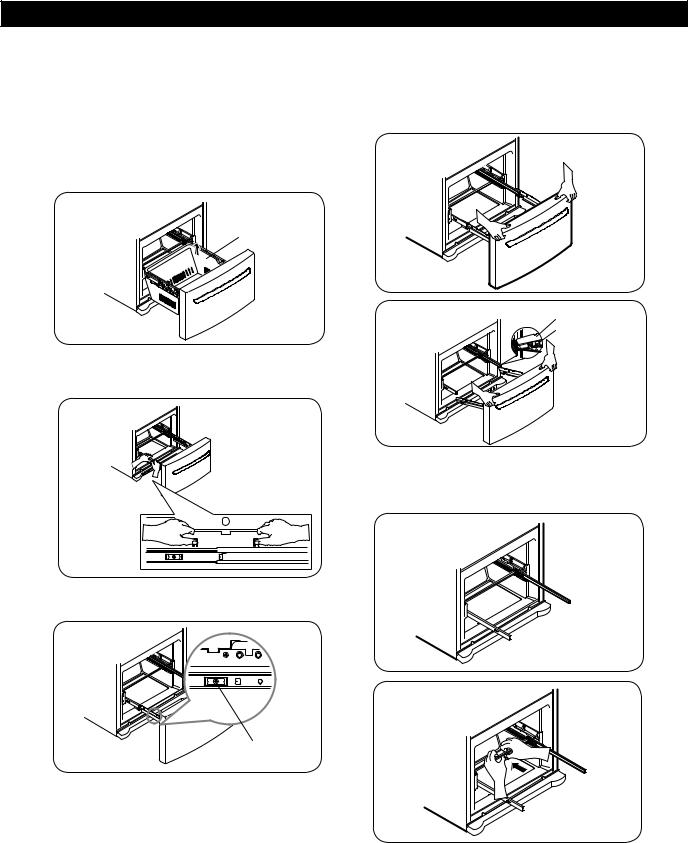
REFRIGERATOR INSTALLATION
HOW TO REMOVE AND INSTALL THE PULL OUT DRAWER
1. Removing Pull out Drawer
IMPORTANT: To avoid possible injury, product or property damage, you will need two persons to perform the following instructions.
•Pull the drawer open to full lower extension. Remove the durabase by lifting it from rail system. (Fig. 1)
Fig. 1
Durabase
 CAUTION: When laying down the drawer, be careful not to damage the floor or hurt your feet with the sharp edges on hinge side.
CAUTION: When laying down the drawer, be careful not to damage the floor or hurt your feet with the sharp edges on hinge side.
•With both hands, hold both sides of the door (Fig. 4) and pull it up to separate it from the rails. (Fig. 5)
Fig. 4
•Put pressure on the two hangers (2) with your thumbs in order to lift it up. (Fig. 2)
•Separate the left and right rail cover.
Fig. 2
2
•Remove the screws of the rail on both sides. (Fig. 3)
Fig. 3 
screw
 CAUTION: When removing drawer door, do not hold it by the handle. The door could fall down and you may be injured. Grasp the door with both hands as pictured below when removing.
CAUTION: When removing drawer door, do not hold it by the handle. The door could fall down and you may be injured. Grasp the door with both hands as pictured below when removing.
Door
Fig. 5  supports
supports
Rail tabes
•Push the rails back into drawer cavity. With both hands, hold the center of the bar and push it in so that both rails go back simultaneously. (Fig.6) (Fig. 7)
Fig. 6
Fig. 7
9
